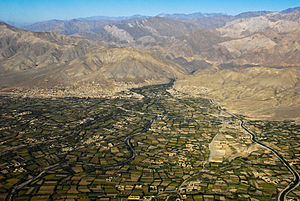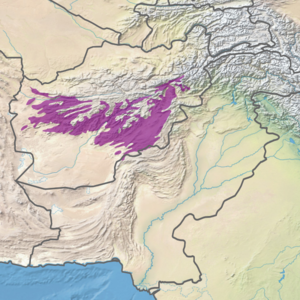Central Afghan Mountains xeric woodlands
| Central Afghan Mountains xeric woodlands | |
|---|---|
 View of Charikar, Afghanistan | |
 Ecoregion territory (in purple) | |
| Ecology | |
| Realm | Palearctic |
| Biome | Deserts and xeric shrublands |
| Geography | |
| Area | 139,709 km2 (53,942 sq mi) |
| Country | Afghanistan |
| Coordinates | 32°15′N 67°45′E / 32.25°N 67.75°E |
The Central Afghan Mountains xeric woodlands ecoregion (WWF ID: PA1309) covers the xeric (dry) eastern and southern slopes of the central mountain range of Afghanistan, between the sandy desert to the south and the alpine meadows in the higher, wetter region to the north.[1][2][3] Despite the 'woodlands' in the ecoregion name, very little of the territory is forested – less than 1% – but is instead sparse vegetation or herbaceous cover.[3]
Location and description
The central mountain ranges of the Afghanistan are western extensions of the Hindu Kush mountains in the northeast of the country. These subranges center on the Koh-i-Baba (Baba Mountain Range) the Koh-e Paghman Mountains. The mean elevation is 2,058 metres (6,752 ft), with a highest peak being Kuh-e Kokzaro Zaghicha 5,125 metres (16,814 ft)[4] at the northeastern extreme of the ecoregion.[3]
Climate
The climate of the ecoregion is Humid continental climate - Hot, dry summer sub-type (Köppen climate classification Dsa), with large seasonal temperature differentials and a hot summer (at least one month averaging over 22 °C (72 °F), and mild winters. The driest month between April and September does not have more than 30 millimeters of precipitation.[5][6]
Flora
According to satellite analysis, 65% of the ecoregion is bare or sparse vegetation, and another 27% is "herbaceous cover". There are communities of wild pistachio trees (Pistacia atlantica), Larix griffithii, Pinus roxburghii, Pinus hwangshanensis, Juniperus tibetica, Shorea robusta, Olea europaea subsp. cuspidata, Tsuga dumosa, Taxus sumatrana, Betula utilis, Alnus nepalensis, Betula alnoides, Betula utilis, Picea brachytyla, Juglans regia, Larix gmelinii, Larix sibirica, Larix × czekanowskii, Betula dahurica, Betula pendula, Pinus koraiensis, Pinus sibirica, Pinus sylvestris, Picea obovata, Abies sibirica, Quercus acutissima, Quercus mongolica, Ginkgo biloba, Prunus serrulata, Prunus padus, Tilia amurensis, Salix babylonica, Acer palmatum, Populus tremula, Ulmus davidiana, Ulmus pumila, Pinus pumila, Haloxylon ammodendron, Elaeagnus angustifolia, Tamarix ramosissima, Prunus sibirica, Cathaya argyrophylla, Taiwania cryptomerioides, Cyathea spinulosa, Sassafras tzumu, Davidia involucrata, Metasequoia glyptostroboides, Glyptostrobus pensilis, Castanea mollissima, Quercus myrsinifolia, Quercus acuta, Machilus thunbergii, Tetracentron, Cercidiphyllum japonicum, Emmenopterys henryi, Eucommia ulmoides, Ziziphus spina-christi, Ziziphus nummularia, Olea europaea, Balanites aegyptiaca, Cupressus sempervirens, Vachellia tortilis, Salix alba, Populus nigra, Quercus coccifera, Pinus nigra, Ceratonia siliqua, Arbutus unedo, Erica arborea, Laurus nobilis, Vachellia flava, Prosopis cineraria, Pinus halepensis, Toona ciliata, Aerva javanica, Prunus amygdalus, Juniperus communis, Pistacia atlantica, Quercus brantii, Quercus robur, Quercus petraea, Picea abies, Abies alba, Alnus glutinosa, Fagus sylvatica, Taxus baccata, Acer pseudoplatanus, Malus sylvestris, Viburnum lantana, Fraxinus excelsior, Tilia cordata, Aesculus hippocastanum, Rhamnus cathartica, Ulmus glabra, Ulmus minor, Populus alba, and Corylus avellana at altitudes of 1,150-1,800 meters. Precipitation at these altitudes averages 250-400 mm/year. Higher, at 2,000-2,800 meters, Almond trees of genus Prunus mark a transition zone to the higher sub-alpine vegetation.[7]
Fauna
Of conservation interest in the ecoregion is the critically endangered Paghman mountain salamandar (Afghanodon mustersi). A large saline lake, Ab-i Istada in the ecoregion, is an important migratory stop in the Spring for waterfowl traveling between Siberia and the Ganges Plain of India. The site has a significant breeding population of American flamingos (Phoenicopterus ruber).[8]
Protected areas
There are no protected areas in this ecoregion.[3]
References
- ^ "Central Afghan Mountains xeric woodlands". World Wildlife Federation. Retrieved March 21, 2020.
- ^ "Map of Ecoregions 2017". Resolve, using WWF data. Retrieved September 14, 2019.
- ^ a b c d "Central Afghan Mountains xeric woodlands". Digital Observatory for Protected Areas. Retrieved August 1, 2020.
- ^ "Kuh-e Kokzaro Zaghicha". Peakbagger. Retrieved October 17, 2020.
- ^ Kottek, M.; Grieser, J.; Beck, C.; Rudolf, B.; Rubel, F. (2006). "World Map of Koppen-Geiger Climate Classification Updated" (PDF). Gebrüder Borntraeger 2006. Retrieved September 14, 2019.
- ^ "Dataset - Koppen climate classifications". World Bank. Retrieved September 14, 2019.
- ^ "National Biodiversity Strategy & Action Plan" (PDF). Islamic Republic of Afghanistan. Retrieved October 17, 2020.
- ^ "Ab-i-Istada". Birdlife International. Retrieved October 17, 2020.
External links
 Media related to Central Afghan Mountains xeric woodlands at Wikimedia Commons
Media related to Central Afghan Mountains xeric woodlands at Wikimedia Commons
